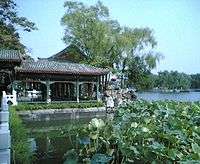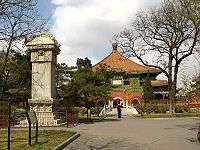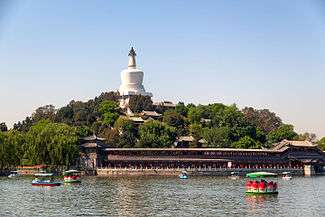Beihai Park
Coordinates: 39°55′28″N 116°22′59″E / 39.92444°N 116.38306°E
| Beihai Park | |
|---|---|
|
The White Pagoda on Qionghua Island | |
| Type | Urban park |
| Location | Beijing, China |
| Area | 71 hectares |
| Created |
1150 (Original) 1925 (Modern Park) |
| Owned by | Beijing Municipal Administration Center of Parks |
| Status | Open all year |
.jpg)





Beihai Park is a public park and former imperial garden located in the northwestern part of the Imperial City, Beijing. First built in the 11th century, it is among the largest of all Chinese gardens and contains numerous historically important structures, palaces, and temples. Since 1925, the place has been open to the public as a park. It is also connected at its northern end to the Shichahai.
The park has an area of more than 69 hectares (171 acres), with a lake that covers more than half of the entire park. At the center of the park is an island called Jade Flower Island (琼华岛; 瓊華島; Qiónghuádǎo), whose highest point is 32 meters (105 ft).
Beihai literally means "Northern Sea". There are also corresponding Central (Zhonghai) and Southern (Nanhai) "Seas". These latter two are joined inside a complex of buildings known after them as Zhongnanhai; it is the home of China's paramount leaders.
The Beihai Park, as with many of Chinese imperial gardens, was built to imitate renowned scenic spots and architecture from various regions of China; the Taihu lake, the elaborate pavilions and canals in Hangzhou and Yangzhou, the delicate garden structures in Suzhou and others all served as inspirations for the design of the numerous sites in this imperial garden. The structures and scenes in the Beihai Park are described as masterpieces of gardening technique that reflects the style and the superb architectural skill and richness of traditional Chinese garden art.[1]
History
In 1179, Emperor Zhangzong of the Jin dynasty had a country resort built northeast of Zhongdu, the Jin capital, located in the southwestern part of modern Beijing. Taiye Lake was excavated along the Jinshui River[2] and Daning Palace (大寧宮) was erected on Qionghua Island in the lake.[3]
During the reign of Kublai Khan in the Yuan dynasty, the Qionghua island was redesigned by various architects and officials such as Liu Bingzhong, Guo Shoujing and Amir al-Din.[4][5] Taiye Lake was enclosed in the Imperial City of Yuan's new capital Dadu
After the Ming dynasty moved its capital to Beijing, construction on the existing Imperial City began in 1406. At this time, the Taiye Lake were divided into three lakes by bridges, Northern Sea (Beihai,北海), Central Sea (Zhonghai,中海) and Southern Sea (Nanhai,南海). The lakes were part of an extensive royal park called Xiyuan (Western Garden,西苑) in the west part of the Imperial City, Beijing.
Notable places
The White Dagoba (白塔, Bai Ta, "White Tower") is a 40-meter (131 ft) high stupa placed on the highest point on Jade Flower Island, built to honour the visit of the 5th Dalai Lama in 1651. Its body is made of white stone. Sun, moon and flame engravings decorate the surface of the tower. Destroyed in 1679 by an earthquake, it was rebuilt the following year, and restored again in 1976 because of the Tangshan earthquake near Beijing. A reliquary, secreted inside the structure are Buddhist scriptures, monk's mantles and alms bowl, and the bones of monks (their remains after cremation).
There are several renowned Buddhist temples located within Beihai Park, such as the Yong'an Temple (Temple of Everlasting Peace) and the Chanfu Temple.
On the north bank lies the Five-Dragon Pavilions, five connected pavilions with spires and pointed upswept eaves, which was built in the Ming dynasty.
The Nine-Dragon Wall lies north of the Five-Dragon Pavilion. It was built in 1402 and is one of three walls of its kind in China. It is made of glazed bricks of seven-colors. Nine complete dragons playing in the clouds decorate both sides of the wall.
Also on the north bank is the Jingxin Room (Quieting Heart Room). It is a garden within the garden, and covers an area of more than 4,000 square meters (43,056 sq ft). Many small traditional Chinese gardens exist throughout the park.
The Round City (团成, Tuancheng) has as its main structure the Hall of Received Light (Chengguangdian), a spacious building with a double-eaved roof made of yellow glazed tiles bordered in green. Inside there is a 1.6 m tall Buddha presented to the Guangxu Emperor of the Qing dynasty by a Khmer (Cambodian) king. It is carved from a single piece of pure white jade inlaid with precious stones. The Eight-Nation Alliance damaged the statue's left arm in the Battle of Beijing in 1900.
In Beihai Park, one could find Taihu rocks shipped from the Henan province and a variety of art collections ranging from jade jars from the Yuan dynasty to a collection of 495 steles bearing inscriptions by trees of hundreds of years old.[1]
Gallery
-
Jade Flower Island
-

The White Pagoda
-
The Five-Dragon Pavilions
-

One of the Five-Dragon Pavilions
-
Pavilion of Sharing Coolness
-

The Dacizhenru Hall
-
Xiao Xi Tian
-

The Miaoxiang Pavilion
-
The Nine-Dragon Wall
See also
- Imperial City, Beijing
- Zhongnanhai
- Summer Palace
- Old Summer Palace
- Miaoying Temple, the site of another famous White Dagoba in Beijing
- Ming tombs
References
- 1 2 "Beihai Park". UNESCO World Heritage Centre. 2008-09-03.
- ↑ Du, Pengfei & al. "History of Water Supply in Pre-Modern China" from Evolution of Water Supply through the Millennia, pp. 169 ff. Accessed 16 November 2013.
- ↑ Rinaldi, Bianca. The Chinese Garden: Garden Types for Contemporary Landscape Architecture, p. 137. Walter de Gruyter, 2011. Accessed 16 November 2013.
- ↑ Steinhardt, Nancy Riva Shatzman (1981). Imperial Architecture under Mongolian Patronage: Khubilai's Imperial City of Daidu. Harvard University. p. 222.
- ↑ "Yeheidie'erding" (Amir al-Din) in Bai Shouyi, Zhongguo Huihui minzu shi. Yang Huaizhong. pp. 813–818.
External links
| Wikimedia Commons has media related to Beihai Park. |

